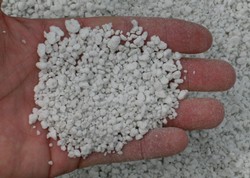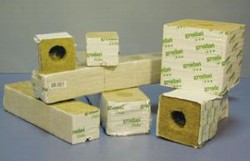The Basics of Hydroponic Media



Just because hydroponic growing mediums are inert doesn't mean that they do not effect your plants. Not only do growing medium support your plants structurally but they also provide oxygen, moisture and nutrients to the roots in varying degrees. If the best possible results are what you're after, then choosing the right hydroponics medium for your particular system and crops can mean the difference between average and explosive results.
Many different man made and organic growing media are available to meet our differing needs. We must weigh our price needs with the requirements of our crops to determine the best possible media for our specific gardening goals. Also, some media are more environmentally friendly than other. Here's a small look at some different types of growing media, what their benefits are as well as drawbacks, and various uses to help take the confusion out of choosing the right one for you.
Rockwool
Rockwool (one of the most popular growing media in use today) is spun wool made of volcanic rock and it comes in many shapes and sizes. Rockwool retains air and water incredibly well and will afford strong structural support to your plants. It typically has a high pH level which can cause pH shifts in your nutrient solution. Because of this, Rockwool does require a 24-hour pre-soaking period. Although rockwool cubes and slabs do not biodegrade, they are seldom reused. Rockwool works well in NFT, Drip, and Ebb and Flow systems.
Expanded Clay Pellets
Expanded clay pellets, unlike rockwool, are easy to reuse again and again. The porous clay pebbles, sometimes referred to as grow rocks, offer strong support for larger plants such as tomatoes, cucumbers, and peppers. Because expanded clay pellets provide plenty of airspace, plant roots stay healthy and oxygen-rich. This medium won't react with nutrient solutions and works well in Aeroponics systems as well as NFT, drip, and Ebb and Flow systems.
Coconut Fiber
Coconut fiber is gaining in popularity because it is biodegradable, durable, rot resistant, and very versatile. Made of compressed, shredded coconut shell fibers, this medium comes in a few different forms. As a result, the use of coconut fiber is not limited to hydroponics. Traditional gardeners sometimes add loose, shredded coconut fiber to soil in place of peat moss; others use shredded coconut fiber as straight mulch. Some hydroponic gardeners top their rockwool with shredded coconut fiber to better retain moisture.
Instead of shredded material, washed, pressed slabs of coconut fiber are commonly used in drip or Ebb and Flow hydroponic systems. Bricked or cubed coconut fiber work well for plant propagation. Because cubed coconut fiber maintains its structure so well, it can be reused, and after use, coconut cubes and slabs can be broken down and used to amend soil. Also, this medium is so absorbent you may want to use extra ventilation.
Soilless Mixes
Perlite and vermiculite are used by themselves or in combination with other soil additives such as coarse sand or peat as soilless mixes for non-recovery drip hydroponics and passive hydroponic wicking systems. Like other growing media, soilless mixes are inert; in other words, they are non-reactive and do not directly provide nutrients to your plants. Typically, soilless mixes are inexpensive and have a near-neutral pH.
Both perlite and vermiculite are great for lightweight plants such as lettuce because they do not crush fine stems and delicate root systems. Soilless mixes containing an even mixture of both are very popular because, while vermiculite retains moisture well, perlite allows for adequate oxygenation. Both of these mined components are reusable.
